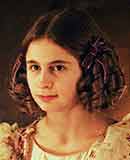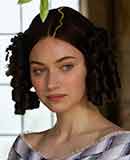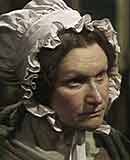Thornfield Hall
The location of Jane's first occupation after leaving Lowood. It is one of Mr Rochester's homes.
The building

Inspirations
There are three buildings which are considered at least a partial inspiration for Thornfield:
- North Lees Hall in Derbyshire
- Rydings Hall in Birstall, West Yorkshire. This was the home of Charlotte's friend, Ellen Nussey.
- Norton Conyers in North Yorkshire
None of the three building accurately represents the descriptions of Thornfield in the book but they each have elements which Charlotte could have taken. North Lees has battlements and three storeys but not the long frontage or bow windows; Rydings has battlements and bay windows of a sort; Norton Conyers has a legend of a mad woman confined to an attic
Links
https://sites.google.com/site/thshomepage/north-lees-hall
http://www.nortonconyers.org.uk/
Location
Thornfield is 50 miles (80 kilometres) towards London from Lowood and 100 miles (160 kilometres) from Gateshead.
Chapter 10. "Thornfield, near Millcote, —shire." … —shire was seventy miles nearer London than the remote county where I now resided: that was a recommendation to me. I longed to go where there was life and movement: Millcote was a large manufacturing town on the banks of the A—; a busy place enough, doubtless: so much the better; it would be a complete change at least. Not that my fancy was much captivated by the idea of long chimneys and clouds of smoke – "but," I argued, "Thornfield will, probably, be a good way from the town."
The only suitable river beginning with "A" is the Aire which runs through Leeds among other places and this would seem to be an apt candidate for Millcote. Thornfield Hall itself is 6 miles (10 kilometres) from Millcote and, interestingly, Rydings Hall is about 7 miles (11 kilometres) from the centre of Leeds.
(Another curious note is that there is an area called Thornhill about 5 miles from Rydings and Charlotte may have heard the name when visiting Ellen Nussey.)
The characters
Mrs Alice Fairfax

The housekeeper at Thornfield who engages Jane as a governess. A kindly woman but of limited conversation.
Chapter 11. …sat the neatest imaginable little elderly lady, in widow's cap, black silk gown, and snowy muslin apron; exactly like what I had fancied Mrs Fairfax, only less stately and milder looking. She was occupied in knitting; a large cat sat demurely at her feet; nothing in short was wanting to complete the beau-ideal of domestic comfort. A more reassuring introduction for a new governess could scarcely be conceived; there was no grandeur to overwhelm, no stateliness to embarrass; and then, as I entered, the old lady got up and promptly and kindly came forward to meet me.
Chapter 12. Mrs Fairfax turned out to be what she appeared, a placid-tempered, kind-natured woman, of competent education and average intelligence.
Chapter 13. "Here is Miss Eyre, sir," said Mrs Fairfax, in her quiet way.
…
and she began to talk. Kindly, as usual – and, as usual, rather trite…
Adèle Varens

The daughter of one of Mr Rochester's love affairs. She was abandoned by her mother so Rochester brought her to Thornfield.
Chapter 11. As I was meditating on this discovery, a little girl, followed by her attendant, came running up the lawn. I looked at my pupil, who did not at first appear to notice me: she was quite a child, perhaps seven or eight years old, slightly built, with a pale, small-featured face, and a redundancy of hair falling in curls to her waist.
Chapter 12. My pupil was a lively child, who had been spoilt and indulged, and therefore was sometimes wayward; but as she was committed entirely to my care, and no injudicious interference from any quarter ever thwarted my plans for her improvement, she soon forgot her little freaks, and became obedient and teachable. She had no great talents, no marked traits of character, no peculiar development of feeling or taste which raised her one inch above the ordinary level of childhood; but neither had she any deficiency or vice which sunk her below it. She made reasonable progress, entertained for me a vivacious, though perhaps not very profound, affection; and by her simplicity, gay prattle, and efforts to please, inspired me, in return, with a degree of attachment sufficient to make us both content in each other's society.
Blanche Ingrams

A beautiful but unpleasant woman who had planned to marry Mr Rochester for his fortune.
Chapter 16. "Tall, fine bust, sloping shoulders; long, graceful neck: olive complexion, dark and clear; noble features; eyes rather like Mr Rochester's: large and black, and as brilliant as her jewels. And then she had such a fine head of hair; raven-black and so becomingly arranged: a crown of thick plaits behind, and in front the longest, the glossiest curls I ever saw. She was dressed in pure white; an amber-coloured scarf was passed over her shoulder and across her breast, tied at the side, and descending in long, fringed ends below her knee. She wore an amber-coloured flower, too, in her hair: it contrasted well with the jetty mass of her curls."
Chapter 16. "And this beautiful and accomplished lady, she is not yet married?" "It appears not: I fancy neither she nor her sister have very large fortunes. Old Lord Ingram's estates were chiefly entailed, and the eldest son came in for everything almost." "But I wonder no wealthy nobleman or gentleman has taken a fancy to her: Mr Rochester, for instance. He is rich, is he not?" "Oh! yes. But you see there is a considerable difference in age: Mr Rochester is nearly forty; she is but twenty-five."
Chapter 17. Blanche and Mary were of equal stature, – straight and tall as poplars. Mary was too slim for her height, but Blanche was moulded like a Dian. I regarded her, of course, with special interest. First, I wished to see whether her appearance accorded with Mrs Fairfax's description; secondly, whether it at all resembled the fancy miniature I had painted of her; and thirdly – it will out! – whether it were such as I should fancy likely to suit Mr Rochester's taste.
As far as person went, she answered point for point, both to my picture and Mrs Fairfax's description. The noble bust, the sloping shoulders, the graceful neck, the dark eyes and black ringlets were all there; – but her face? Her face was like her mother's; a youthful unfurrowed likeness: the same low brow, the same high features, the same pride. It was not, however, so saturnine a pride! she laughed continually; her laugh was satirical, and so was the habitual expression of her arched and haughty lip.
…
Genius is said to be self-conscious. I cannot tell whether Miss Ingram was a genius, but she was self-conscious – remarkably self-conscious indeed.
…
Miss Ingram was dark as a Spaniard.
Chapter 18. She was very showy, but she was not genuine: she had a fine person, many brilliant attainments; but her mind was poor, her heart barren by nature: nothing bloomed spontaneously on that soil; no unforced natural fruit delighted by its freshness. She was not good; she was not original: she used to repeat sounding phrases from books: she never offered, nor had, an opinion of her own. She advocated a high tone of sentiment; but she did not know the sensations of sympathy and pity; tenderness and truth were not in her. Too often she betrayed this, by the undue vent she gave to a spiteful antipathy she had conceived against little Adèle: pushing her away with some contumelious epithet if she happened to approach her; sometimes ordering her from the room, and always treating her with coldness and acrimony.
Grace Poole

A servant employed by Mr Rochester to look after his wife. Generally trustworthy, her main fault is a tendenchy to drink.
Chapter 11. The door nearest me opened, and a servant came out, – a woman of between thirty and forty; a set, square-made figure, red-haired, and with a hard, plain face: any apparition less romantic or less ghostly could scarcely be conceived.
…
"She is a person we have to sew and assist Leah in her housemaid's work," continued the widow; "not altogether unobjectionable in some points, but she does well enough."
Chapter 16. But, having reached this point of conjecture, Mrs Poole's square, flat figure, and uncomely, dry, even coarse face, recurred so distinctly to my mind's eye, that I thought…
Chapter 36. She had a woman to take care of her called Mrs Poole – an able woman in her line, and very trustworthy, but for one fault – a fault common to a deal of them nurses and matrons – she kept a private bottle of gin by her, and now and then took a drop over-much. It is excusable, for she had a hard life of it: but still it was dangerous; for when Mrs Poole was fast asleep after the gin and water, the mad lady, who was as cunning as a witch, would take the keys out of her pocket, let herself out of her chamber, and go roaming about the house, doing any wild mischief that came into her head.
Bertha Rochester née Mason

Mr Rochester's mad wife who is kept in a room in Thornfield rather than being put into an asylum.
Chapter 25. "It seemed, sir, a woman, tall and large, with thick and dark hair hanging long down her back. I know not what dress she had on: it was white and straight; but whether gown, sheet, or shroud, I cannot tell."
…
"Fearful and ghastly to me – oh, sir, I never saw a face like it! It was a discoloured face – it was a savage face. I wish I could forget the roll of the red eyes and the fearful blackened inflation of the lineaments!"
"Ghosts are usually pale, Jane."
"This, sir, was purple: the lips were swelled and dark; the brow furrowed: the black eyebrows widely raised over the bloodshot eyes."
Chapter 26. Bertha Mason is mad; and she came of a mad family; idiots and maniacs through three generations! Her mother, the Creole, was both a madwoman and a drunkard! – as I found out after I had wed the daughter: for they were silent on family secrets before. Bertha, like a dutiful child, copied her parent in both points.
Chapter 26. In the deep shade, at the farther end of the room, a figure ran backwards and forwards. What it was, whether beast or human being, one could not, at first sight, tell: it grovelled, seemingly, on all fours; it snatched and growled like some strange wild animal: but it was covered with clothing, and a quantity of dark, grizzled hair, wild as a mane, hid its head and face.
…
The maniac bellowed: she parted her shaggy locks from her visage, and gazed wildly at her visitors. I recognised well that purple face, – those bloated features.
…
She was a big woman, in stature almost equalling her husband, and corpulent besides: she showed virile force in the contest – more than once she almost throttled him, athletic as he was. He could have settled her with a well-planted blow; but he would not strike: he would only wrestle.
Richard Mason

The brother of Bertha Rochester. A friend of Mr Rochester who is concerned about her treatment.
Chapter 18. it was a tall, fashionable-looking man, a stranger.
…
His manner was polite; his accent, in speaking, struck me as being somewhat unusual, – not precisely foreign, but still not altogether English: his age might be about Mr Rochester's, – between thirty and forty; his complexion was singularly sallow: otherwise he was a fine-looking man, at first sight especially. On closer examination, you detected something in his face that displeased, or rather that failed to please. His features were regular, but too relaxed: his eye was large and well cut, but the life looking out of it was a tame, vacant life – at least so I thought.
…
His eye wandered, and had no meaning in its wandering: this gave him an odd look, such as I never remembered to have seen. For a handsome and not an unamiable-looking man, he repelled me exceedingly: there was no power in that smooth-skinned face of a full oval shape: no firmness in that aquiline nose and small cherry mouth; there was no thought on the low, even forehead; no command in that blank, brown eye.

Fancy a map of the locations in Jane Eyre? There is an excellent printed map available from Literary Maps. Click here to visit.
